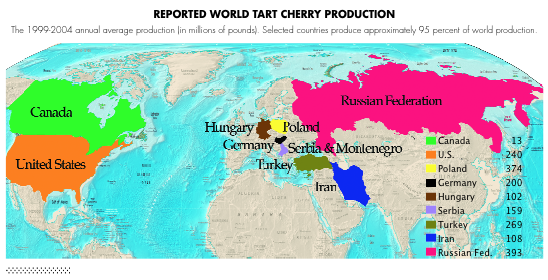
A Michigan State University economist sees both opportunity and threat when considering the place of U.S. tart cherries in the global tart cherry market. New global players are emerging as Russian countries begin exporting more tart cherry products, said MSU agricultural economist Dr. Suzanne Thornsbury.
But opportunities for U.S. producers exist with new products like dried tart cherries and tart cherry juice and concentrate. “There are many potential opportunities,” she said. “It’s not a gloom-and-doom situation.” Reported world production numbers from a five-year average between 1999 to 2004 show that the Russian federated countries lead in tart cherry production with nearly 400 million pounds annually.
Poland is second with about 375 million pounds, followed by Turkey at 270 million, and the United States is fourth with 240 million. One of the problems in gathering world tart cherry data, Thornsbury explained, is that some of the Russian countries have little public data available. At the bottom of the world production lineup are Iran, Hungary, and Canada, which appear to be in a flat production trend.
Countries with increasing production are Poland, Russian countries, Turkey, and Serbia/Montenegro. Germany is the world’s largest importer of tart cherries, she noted. The country took more than 60 percent of the world’s tart cherry exports from 2000 to 2003. Though about 70 percent of Germany’s imports are from Poland, Germany is still an important export market for the U.S. tart cherry industry.
Montmorency cherries are popular with German bakers and chefs because the cherries don’t bleed red juice during baking. “We have a strong niche market there.” In comparing U.S. production costs and Poland’s, Thornsbury found that average costs are not that different, varying only a few cents per pound. “But in Poland there is a huge range of production costs that go into making the average —from 3 cents to 49 cents per pound. The range is capturing the diversity of what’s happening as the industry moves to modern training systems.”
Dried cherries
Thornsbury, who shared her outlook on global tart cherry production during the Great Lakes Fruit, Vegetable, and Farm Market Expo in Grand Rapids, Michigan, sees potential for U.S. exports of dried cherries and especially branded product. During a recent visit to Ukraine, she found a diversity of dried cherry products sold there.
Product in the market represented varying degrees of quality and color. Some dried cherries were even sold with pits. Most of the product came from other countries. “There’s a lot more trade coming out of the former Soviet Union countries,” she said, “but most of the information is based on secondary data.
Production numbers of tart cherries are hard to come by. Ukraine is still very much in transition as the country is working through land ownership and land tenure.” She saw few new plantings in Ukraine and noted that processors are short of product. In Serbia, she observed a cherry industry still in transition, with investment in the processing sector, but not in the orchards.
Opportunities
“There are a lot of unknowns on the global market,” she said. “We know little about the Russian federated countries. One of the greatest unknowns is China. We continue to hear stories from there, but haven’t found anything yet.” But she does see opportunities for exports that move toward a more consumer-oriented product, with branding, quality standards, and consumer packaging.
Opportunities also exist in domestic markets. The United States continues to import cherry juice and dried cherries from European countries and China. The U.S. tart cherry industry has potential for growth by creating new alliances and targeting exports and ethnic markets, Thornsbury noted. The tart cherry health message has also affected consumer demand in a positive way.
Thornsbury concluded that the U.S. tart cherry industry must continue to think globally, though not all trading must be done on a global basis. However, issues like bulk versus consumer-oriented products and packaging must be thought of in a global context. m





Leave A Comment